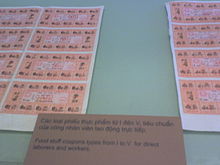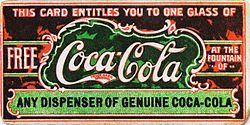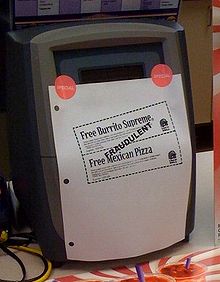- Coupon
-
This article is about a document exchanged in a financial transaction. For other uses, see Coupon (disambiguation).
 Food stuff coupons types I-V for direct laborers and workers at Vietnam in period 1976–1986
Food stuff coupons types I-V for direct laborers and workers at Vietnam in period 1976–1986
In marketing, a coupon is a ticket or document that can be exchanged for a financial discount or rebate when purchasing a product. Customarily, coupons are issued by manufacturers of consumer packaged goods or by retailers, to be used in retail stores as a part of sales promotions. They are often widely distributed through mail, magazines, newspapers, the Internet, directly from the retailer, and mobile devices such as cell phones. Since only price conscious consumers are likely to spend the time to claim the savings, coupons function as a form of price discrimination, enabling retailers to offer a lower price only to those consumers who would otherwise go elsewhere. In addition, coupons can also be targeted selectively to regional markets in which price competition is great.
In government, a coupon is a paper certificate used to administer a benefit or permission.
Contents
Pronunciation
The word is of French origin, pronounced [kuˈpɔ̃]. In Britain and Canada it is pronounced /ˈkuːpɒn/ koo-pon. A common alternate American pronunciation is /ˈkjuːpɒn/ cue-pon. Another increasingly popular term of pronunciation is /ˈkjuːpɨn/ cue-pin. This is especially prevalent in the Southern United States.
 Believed to be the first coupon ever, this ticket for a free glass of Coca-Cola was first distributed in 1888 to help promote the drink. By 1913, the company had redeemed 8.5 million tickets.[1]
Believed to be the first coupon ever, this ticket for a free glass of Coca-Cola was first distributed in 1888 to help promote the drink. By 1913, the company had redeemed 8.5 million tickets.[1]
History
Origin
In 1887, the Coca-Cola Company was incorporated with Asa Candler as one of the partners. He transformed Coca-Cola from an insignificant tonic into a profitable business by using innovative advertising techniques. The key to this growth was Candler's ingenious marketing including having the company's employees and sales representatives distribute complimentary coupons for Coca-Cola.[2] Coupons were mailed to potential customers and placed in magazines. The company gave soda fountains free syrup to cover the costs of the free drinks. It is estimated that between 1894 and 1913 one in nine Americans had received a free Coca-Cola, for a total of 8,500,000 free drinks. By 1895 Candler announced to shareholders that Coca-Cola was served in every state in the United States.
Widespread use
Coupons first saw widespread use in the United States in 1909 when C. W. Post conceived the idea to help sell breakfast cereals and other products. Today,[when?] more than 2,800 consumer packaged goods companies offer coupons for discounts on products. In 2010, coupon transactions for consumer packaged goods amounted to 3.7 billion dollars within the U.S.[3]
Timeline
A timeline for the history of coupons:[citation needed]
1888 – Asa Candler used paper tickets for free glasses of Coke to help market his new soda
1909 – C.W. Post used 1 cent coupons to start marketing Grape Nuts breakfast
1930 – Coupon usage grows dramatically during the great depression
1940 – Big chain grocery stores begin to use coupons to attract consumers away from purchasing at local markets
1957 – Nielsen Coupon Clearing House was created to be devoted entirely to coupon redemption
1965 – Half of all the families in the United States begin cutting coupons
1990 – The invention of the internet leads to the downloaded printable coupon and online coupons
1992 – The last year coupon usage is on the rise for the next 17 years
2002 – Americans saved $3.8 billion shopping with coupons
2009 – The U.S. government uses coupons to promote converter box sales for the digital television transition
Types and uses
There are many different types of coupons such as discounts, free shipping,, buy one get one, first-time customer coupons, and free giveaways.
Function
Coupons can be used to research the price sensitivity of different groups of buyers (by sending out coupons with different dollar values to different groups). In addition, it is generally assumed that buyers who take the effort to collect and use coupons are more price sensitive than those who do not. Therefore, the posted price paid by price-insensitive buyers can be increased, while using coupon discounts to maintain the price for price-sensitive buyers (who would not buy at a higher price).[4]
Grocery coupons
The grocery coupons have the advantage of being usable with most retailers and not with only one brand or store. As the other types of coupons, grocery coupons are intended for people who are willing to save money when purchasing groceries but also to direct people towards buying a new type of product which normally will not have as many buyers as with the grocery coupons. They may also be used to increase the sales of a certain newspaper for example, as many people who have discovered the savings they can do with these coupons, tend to buy more than just one copy of that newspaper or magazine.
Some grocery stores double the value of a grocery, especially for products that normally are not very well sold.[5]
Welfare coupons
The welfare coupons are coupons given to people who are considered to be living in poverty or at risk of living in poverty. According to the statistics, 19% of people under 18 years, 11.7% among people 18 to 64 years and 9.7% for people ages 65 and older were in 2008 living in poverty in the United States. According to the U.S. Census, over 39 million people were living in poverty in the United States, in 2008 which gets the total poverty rate to 13.2%.[6] On the other hand there are many social programs intended to help these people and whereas some of them provide cash payments for a certain number of hours worked in various activities, most of these programs provide welfare coupons that come mostly as grocery coupons.
The welfare coupons are intended to help people with very low incomes to be able to partially satisfy their nourish needs. One of the most popular programs that provide food vouchers to a certain category of people is Women, Infants, and Children (WIC). The program is limited to pregnant women and children under 5 years old and the grocery coupons may be used to buy certain products such as cheese, milk, eggs, and some breakfast cereals.
Fundraising companies may also provide welfare coupons for people who are willing to donate certain amounts of money or to adopt animals.[7] These welfare coupons may come as discount coupons for various products or for buying food for the adopted animal.
Delivery methods
Customers may get these coupons from various sources, including national newspapers and the Internet, with web sites offering free printable grocery coupons can be printed at home and use them at retail store. Some major grocery chains also produce digital coupons that may be loaded onto the retailer's store card at home, or at a coupon dispensing machine located in store.
Print media
Clipping coupons from newspapers has been the most popular way to obtain coupons, though Internet and Mobile Phone coupons are gaining wide popularity. Based on its annual RedPlum Purse String Study surveying more than 23,000 shoppers, a coupon provider, Redplum, reports 76% of coupon-seekers utilize newspapers as their primary source for coupons and deals; 59% find coupons in e-mails and coupon alerts, an 29% increase from 2010; and 33% use Internet searches to find coupons.
Many retailers and companies use verification methods such as unique barcodes, coupon ID numbers, holographic seals, and watermarked paper as protection from unauthorized copying or use.
Other than newspaper, there are also coupon book publishers and retailers who compile vouchers and coupons into books, either for sale or free.
Internet coupons
Online retailers often refer to coupons as "coupon codes," "promotional codes," "promotion codes," "discount codes," "key codes," "promo codes," "surplus codes," "portable codes," "shopping codes," "voucher codes," "reward codes" "discount vouchers" or "source codes." Internet coupons typically provide for reduced cost or free shipping, a specific dollar or percentage discount, or some other offer to encourage consumers to purchase specific products or to purchase from specific retailers. Because paper coupons would be difficult to redeem, typically secret words or codes are distributed for consumers to type in at checkout. Marketers can use different codes for different channels our groups in order to distinguish response rates.
Mobile coupons
A Mobile coupon is an electronic ticket solicited and or delivered to a mobile phone that can be exchanged for financial discount or rebate when purchasing product or service. Customarily coupon are issued by manufacturers of consumer packaged goods or retailers, to be used in retail stores as part of a sales promotion. They are often distributed through WAP Push over SMS or MMS, or other mobile means. The customer redeems the coupon at store or online. In some cases customer redeems the mobile coupon at store; some retailers forward the redemption to a clearinghouse for final processing. What's unique about mobile coupons is the memory of information in the coupons often outlast the expiry dates of the coupons themselves, triggering actual purchases at later dates (Banerjee,Poddar,Yancey,McDowell 2011). Researchers suspect it's driven by the engagement generated by the mobile device.
Taxation
Depending on the jurisdiction, coupons may or may not reduce the sales tax which must be paid by the consumer. This is often determined by who sponsors the coupon. If the coupon is issued by the retailer, the product was never offered at the original price and the coupon represents a reduction in the amount paid and the tax. If the coupon is issued by the manufacturer, the original price is still paid but some of the price is covered by the manufacturer instead of the consumer and the full price remains taxable. This is the case with the coupon-eligible converter boxes in the U.S., which compensate in part for the forced conversion to digital TV. Mobile coupons have become very popular among US fast-food customers.The primary success factors for the SMS campaigns are discount size, how the discount value is framed (as a gift or percent off) and the timing of the campaign (Banerjee and Yancey, 2010), among many others.
Trading
Coupon manufacturers may or may not place restrictions on coupons limiting their transferability to ensure the coupons stay within the targeted market. Since such restrictions are not universal and are difficult and/or costly to enforce, limited coupon trading is tolerated in the industry. Organized coupon exchange clubs are commonly found in regions where coupons are distributed. Often coupons are available for purchase at some online sites, but since most coupons are not allowed to be sold, the fee is considered to be for the time and effort put into cutting out the coupons.
See also
- Canadian Tire Money
- Coupon (bond)
- Drug coupon
- Love coupon
- Trading stamp
- Normal yield
References
- ^ Geuss, Megan (October 2010), "First Coupon Ever", Wired 18 (11): 104.
- ^ Coca-Cola 120th Anniversary The Coca-Cola Company Time Line – 120 Years of Innovation
- ^ "NCH Annual Coupon Facts Report, 2011". NCH Marketing Services, Inc.. https://www.nchmarketing.com/ResourceCenter/default.aspx. Retrieved 15 June 2011.
- ^ McKenzie, Richard B. Why Popcorn Costs So Much at the Movies: And Other Pricing Puzzles. ISBN 978-0-387-76999-8, 2008.
- ^ "Grocery Stores That Double Coupons". http://couponing.about.com/od/groceryzone/a/doublecoupons.htm.Retrieved=2010/04/13
- ^ "Welfare Statistics". http://www.census.gov/Press-Release/www/releases/archives/income_wealth/014227.html.Retrieved=2010/04/13
- ^ "Make Your Voice Heard! Lousiana Legislative Bill SB 73". http://www.paaw.org/.Retrieved=2010/04/13
8. Banerjee,Sy and Yancey Scott(2010), "Enhancing mobile coupon redemption in fast food campaigns", Journal of Research in Interactive Marketing, Vol. 4 Iss: 2, pp.97 - 110
9. Banerjee, Syagnik (Sy), Poddar Amit, Yancey, Scott and Mc Dowell Danielle (2011), "Measuring Intangible Effects of M-Coupon Campaigns on Non-Redeemers" Journal of Research in Interactive Marketing, Forthcoming.
External links
 Media related to coupons at Wikimedia Commons
Media related to coupons at Wikimedia Commons The Wiktionary definition of coupon
The Wiktionary definition of coupon
Categories:- Promotion and marketing communications
- Marketing
- Sales promotion
Wikimedia Foundation. 2010.

